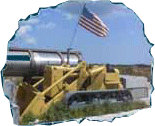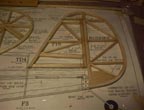
The
curved Tail and rudder sections are laminated to form a light, clean rounded
surface.
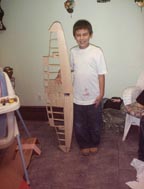
The
Wing framed and sheeted, the landing gear have been installed and the servo
can be seen. |
I
Purchased the Great Planes Spitfire 40 kit after reading an electric conversion
article in Radio Control magazine (RCM). I really love war birds and the Spitfire
is right up there with the P51. I also wanted a plane with retracts. After
reading the article I decided this was the plane for me. I consulted with
Tom Hunt about motor configurations. As per the article, I also felt it was
a 16 cell plane but did not want to go with a brushed motor (Astro geared
25). Tom felt the Mega ACn22/30/3, with the Modelair-Tech 750 belt drive will
fill the ticket. I already have this configuration in my Fokker D7 and it
works great.
When I
finally decided to buy the kit there was not one available, Great Planes had
discontinued it and all the hobby shops in the states and Canada had sold
out. I searched the internet and finally found a kit in New Zealand! Gulp...
buy a kit from New Zealand... would it ever get here? in one piece? would
I get a global rip off? Hey.. what the hell... I really wanted to build this
kit. The money conversion was straight forward, the price was comparable to
here in the U.S., and twenty and change wasn't too bad for shipping, so I
did it. Four days later a substantially packed box arrived at my job with DHL
stickers all over it. I anxiously opened the carton and carefully checked
the parts, all present and accounted for. This all happened around Christmas
2002, I built the tail pieces around January 1, 2003 and have working ever
so slowly building the kit I would like to show some of the photos I have
collected so far.
Tom Reilly
|
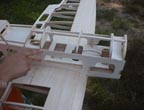
I am showing
the battery hatch construction. I made three extra formers and after sheeting
was able to cut the hatch free.
You can
see the lite ply battery tray this was left over from the servo tray which
I removed.
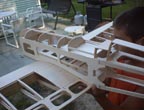
A
view looking forward shows the very light structure. Even with the light ply
fuselage doublers the plane should come in around 7 pounds.
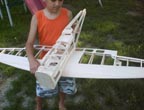 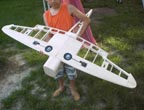
The next
step is installing the wing servos, I am using Hitec HS-85MG servos for the
rudder, elevator and the two ailerons. The part I hate the most is aligning
the horizontal and vertical stabilizers. Which I might add is ready to do.
|

